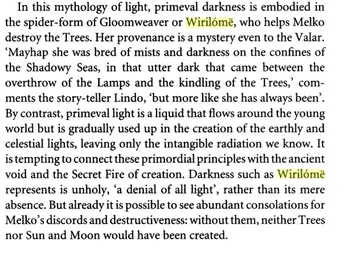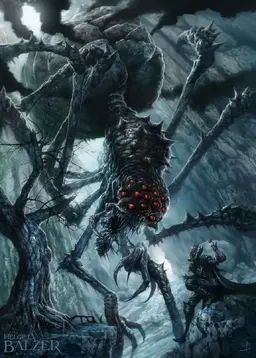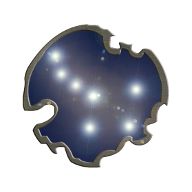Tolkien's Time Ethics
Mostly Tolkien metas. Occasionally comics.
Tolkien’s Ungoliant and Stephen King’s It – some interesting parallels
Scene from
It (1990) - the Losers confront Its ‘true’ from.
While watching the recent adaptation of Stephen King’s
It (2017) and reacquainting myself with King’s work in general throughout the past year (including watching some older adaptations of his books, among which was also the 1990 miniseries
It), my mind was constantly going back to Ungoliant, Morgoth and the
Silmarillion.
Why? Well, some of it undoubtedly has to do with my ongoing interest in Tolkien, but I also managed to find some parallels between Ungoliant and It, and Morgoth and the arch villain of the Kingverse, the Crimson King.
Long story short, enjoy me shamelessly hopping on the It bandwagon!
Warning for the arachnophobic.
So, what do Ungoliant and It have in common?
They both:
1) assume a form of a (female) spider
2) have hunger as one of their defining traits
3) use Deadlights/Darkness, a fear inducing form of ‘unlight’ which traps their victims (connected to the spider form), also used by the Crimson King/Morgoth
4) are ancient and have a somewhat unclear origin
5) have a loose allegiance with the Big Bad’s of their universes (Morgoth/the Crimson King)
What do Morgoth and the Crimson King have in common?
They:
1) use Darkness (Unlight)/Deadlights to achieve their ‘goals’ - Melkor uses it to steal the Silmarils and kill the Trees, and the Crimson King uses it as a weapon (according to
The Dark Tower Wiki)
2) have a loose allegiance with a hungry spider-like being who also uses Darkness (Unlight) /Deadlights)
3) both are Big Bads of their respective fictional universes
4) both are trying to rewrite reality in their own image
NOTE: Others have already found some references to the Crimson King being similar to Sauron (
The Dark Tower Wiki page on the Crimson King, under ‘Inspiration’). I haven’t yet come across any articles comparing him to Morgoth which I believe to be a better position (to me Randall Flagg seems like a more credible reference to Sauron, even though, of course, overlaps are possible, both because Sauron imitated Morgoth in-universe and because King could have fused them on purpose).
So, let’s first break down the similarities between It and Ungoliant.
While Ungoliant takes the form of a giant spider and is referred to as female, It’s ‘final’ form is also a giant spider.
In the novel
It the Losers call It
the Spider (i.e. “The Spider stopped laughing”
, It p 4153). It also seems to be considered by the Losers as femal(ish) as they refer to It as a 'bitch’ several times (“You k-k-killed my brother, you fuh-fuh-fucking BITCH” (…) p 4099, including the somewhat paradoxical “We killed
It” (…) “We killed the
bitch.”,
It, p 4289) after discovering It’s
eggs (
It, p 4212).
It’s spider-form was also shown overtly in the finale of the 1990 miniseries
It, as a kind of a 'boss-form’ for the Losers to fight:
In the new It adaptation the spider imagery is covert, but still pervasive in the way Pennywise (definitely less ambiguously masculine, in my opinion, than in the 1990 adaptation) behaves and operates. This makes ‘the spider’ more than just another of It’s many forms designed to induce fear.
For example,
It lives in the sewers, which are a kind of a web. The new film puts great emphasis on this, giving us both Bill’s model of the sewers and a map of them, both of which serve as visualizations of a ‘spider-web’. The ‘sewer web’ is also in a sense ‘invisible’ (like a real spider web) because it is underground. Thus it is both a hiding place for It and a trap for It’s prey.
Furthermore, as we can see in the Losers first individual encounters with It, the prey Pennywise finds by using the sewers are paralyzed by their own fears - the fears not produced directly by It, but by the ‘mundane’ (as opposed to the ‘supernatural’) part of the plot - mostly bullies and abusive parents. Arguably, It first finds the Losers because they are afraid. Pennywise uses fear (in the new movie It
smells fear) to locate its victims and moves through the sewers accordingly, like a spider traverses its own web when its prey becomes entangled in it and it feels the vibrations the prey produces. Fear, in a sense, produces ‘vibrations’ in Pennywise’s spiderweb.
Pennywise’s likeness to a spider in the new adaptation is also shown in the scene where the kidnapped children are suspended in air, as if trapped in some invisible spider web, stashed in a spider’s pantry.
As we can see when Pennywise suspends Beverly Marsh in the same way, all the children there are paralyzed by fear, the aftereffect of looking directly into It’s deadlights. Fear is the spider venom which keeps It’s victims paralyzed and helpless. Deadlights are like a high-concentrate fear-venom that leaves you senseless.
No matter what form It assumes, It always
acts like a spider.
Stephen King Wiki says the following on this issue:
“Throughout the book It is generally referred to as male; however, late in the book, the protagonists come to believe that It may be female (due to Its manifestation as
a monstrous female spider). This is, however, not Its true form, it is simply the closest the human mind can come to approximating it (…) Its natural form exists in a realm beyond the physical, which It calls the ‘deadlights‘. (…)
Coming face to face with the deadlights drives any living being instantly insane.”
This can be compared with the description of the darkening of Valinor and the Elves and Valar’s experience of ‘the Darkness’ that Ungoliant has 'woven’:
“So the great darkness fell upon Valinor. Of the deeds of that day much is told in the
Aldudénië, that Elemmírë of the Vanyar made and is known to all the Eldar. Yet no song or tale could contain all the grief and terror that then befell.The Light failed; but
the Darkness that followed was more than loss of light. In that hour was made a Darkness that seemed not lack but a thing with a being of its own: for it was indeed made by malice out of Light, and it had power to pierce the eye, and to enter heart and mind, and strangle the very will.” (Silmarillion)
The Darkness that Morgoth unleashed on Valinor with Ungoliant’s help
paralyzed the Elves and the Valar to such a degree than they couldn’t immediately pursue them.
It also interesting that, similarly to the paradoxically sounding name 'Deadlights’, Ungoliant’s darkness also gets a paradoxical negative prefix - ‘un’, ('Unlight of Ungoliant’ (Silmarillion p34)). Both present fear, in a sense, but in Tolkien’s case I would argue that the Darkness/Unlight presents above all
fixation on the experienced loss, and not moving on creatively
, still aptly shown by the spider imagery.
What also comes to mind here is Frodo’s and Sam’s confrontation with Shelob in Shelob’s Lair in
The Two Towers.
The new movie’s whole 'Neibolt house hunt’ sequence reminds me very much of that, mainly because Beverly gives It a really good stab in the head after which It retreats like a wounded Shelob when stabbed by Sam. Also, the tunnels of Shelob’s lair are like a 3D spider web, much like King’s town of Derry sewer system is It’s spider web, with the emphasized spacial quality - you are not
on the web, you are
in the web.
And, yeah, Frodo almost gets stashed in the spider’s pantry, like Beverly.
Furthermore, Tolkien describes Sam’s fear like something akin to an invisible spider web of Shelob:
“But nothing of this evil which they had stirred up against them did poor Sam know, except that a fear was growing on him, a menace which he could not see; and such a weight did it become that it was a burden to him to run, and his feet seemed leaden.” (TTT,
Shelob’s Lair)
Sam literally has difficulty moving because of his fear. Then a little bit later he has a moment of ultimate ‘fixation’, a moment of paralyzing fear - he believes Frodo to be dead:
“‘He’s dead!’ he said. ‘Not asleep, dead!’ And as he said it, as if the words had set the venom to its work again, it seemed to him that the hue of the face grew livid green. And then black despair came down on him, and Sam bowed to the ground, and drew his grey hood over his head, and night came into his heart, and he knew no more. When at last the blackness passed, Sam looked up and shadows were about him; but for how many minutes or hours the world had gone dragging on he could not tell. He was still in the same place, and still his master lay beside him dead.” (TTT,
The Choices of Master Samwise)
It’s like Sam took a glance at the Deadlights. Notice also how this despair is first described as 'black’, which is a fairly common construction ('black despair’), but then 'blackness’ is described as an entity on it’s own, like it is described in
The Darkening of Valinor - “a thing with a being of its own”.
However, Sam manages to disentangle himself from this web – there is a moment of fixation on the experienced loss, but then he goes to the ‘underground’ (externalized by him literally being underground, in Shelob’s lair) of his own thoughts and feelings (this chapter is not named for nothing 'The Choices of Master Samwise’) and manages to move on with the objective of the Fellowship’s mission on his mind:
“‘But what can I do? (…) Or go on? Go on?’ he repeated, and for a moment doubt and fear shook him. ‘Go on? Is that what I’ve got to do? And leave him?’ (…)"‘What? Me, alone, go to the Crack of Doom and all?’ He quailed still, but the resolve grew. ‘What?
Me take the Ring from
him? The Council gave it to him.’ But the answer came at once: ‘And the Council gave him companions, so that the errand should not fail. And you are the last of all the Company. The errand must not fail.’” (TTT)
At this moment Sam passes Tolkien’s ethical test - he is able to ‘go on’, even after a crippling loss.
So, that would be points 1) and 3).
2) hunger as a defining trait
Hunger is also a big parallel here. Pennywise practically only sleeps (hibernates) and eats, and Ungoliant (just like her offspring Shelob) is always hungry. She ate the Trees’s sap. She tried to eat Morgoth and the Silmarils:
'Blackheart!’ she said. 'I have done thy bidding. But I hunger still.’ (Silm)
She even ate her sex partners:
“(…) other foul creatures of spider form had dwelt there since the days of the delving of Angband, and she mated with them, and devoured them”
And, in the end, probably herself:
“Of the fate of Ungoliant no tale tells. Yet some have said that she ended long ago, when in her uttermost famine she devoured herself at last.”
In the novel, Pennywise describes itself in terms of it’s hunger:
“(…) I am the eater of worlds, and of children. And you are next!”
I didn’t address everything I listed in this post, in particular, those last two parallels between Ungoliant and It:
4) they are ancient and have a somewhat unclear origin
5) they have a loose allegiance with the Big Bad’s of their universes (Morgoth/the Crimson King).
These are tightly connected with the second list that explains the parallels between Morgoth and the Crimson King so I will elaborate on them together in my next post.
Thank you for reading this.

 O C.S. Lewis pegou o vírus "trocadalho do carilho" do Tolkien
O C.S. Lewis pegou o vírus "trocadalho do carilho" do Tolkien

 O C.S. Lewis pegou o vírus "trocadalho do carilho" do Tolkien
O C.S. Lewis pegou o vírus "trocadalho do carilho" do Tolkien















 A natureza de Ungoliant pode ser atribuída realmente a um 'buraco negro' possuidor de um 'invólucro' vivo e dotado de consciência?
A natureza de Ungoliant pode ser atribuída realmente a um 'buraco negro' possuidor de um 'invólucro' vivo e dotado de consciência?












 ) de A Lenda-Legend?
) de A Lenda-Legend?










